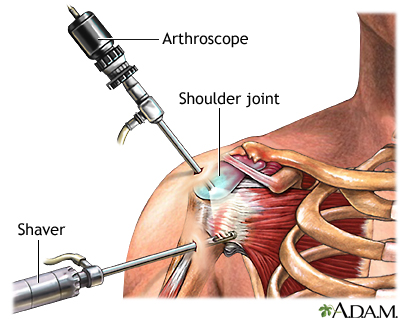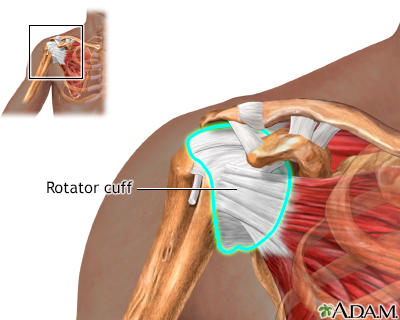Shoulder arthroscopy
SLAP repair; SLAP lesion; Acromioplasty; Bankart repair; Labral repair; Bankart lesion; Shoulder repair; Shoulder surgery; Rotator cuff repair
Shoulder arthroscopy is surgery that uses a tiny camera called an arthroscope to examine or repair the tissues inside or around your shoulder joint. The arthroscope is inserted through a small cut (incision) in your skin.
Images


Description
The rotator cuff is a group of muscles and their tendons that form a cuff over the shoulder joint. These muscles and tendons hold the arm in the shoulder joint. This also helps the shoulder move in different directions. The tendons in the rotator cuff can tear when they are overused or injured.
You will likely receive general anesthesia for this surgery. This means you will be asleep and unable to feel pain. Or, you may have regional anesthesia. Your arm and shoulder area will be numbed and as a result, you do not feel any pain. If you receive regional anesthesia, you will also be given medicine or general anesthesia to make you very sleepy during the operation.
During the procedure, the surgeon:
- Inserts the arthroscope into your shoulder through a small incision. The scope is connected to a video monitor in the operating room.
- Inspects all the tissues of your shoulder joint and the area above the joint. These tissues include the cartilage, bones, tendons, and ligaments.
- Repairs any damaged tissues. To do this, your surgeon makes 1 to 3 more small incisions and inserts other instruments through them. A tear in a muscle, tendon, or cartilage is fixed. Any damaged tissue is removed.
Your surgeon may do one or more of these procedures during your operation:
Rotator cuff repair:
- The edges of the tendon are brought together. The tendon is attached to the bone with sutures.
- Small rivets (called suture anchors) are often used to help attach the tendon to the bone.
- The anchors can be made of metal, plastic, or suture material alone. They do not need to be removed after surgery.
Surgery for impingement syndrome:
- Damaged or inflamed tissue is cleaned out in the area above the shoulder joint.
- A ligament called the coracoacromial ligament may be cut.
- The underside of a bone called the acromion may be shaved. A bony growth (spur) on the underside of the acromion often causes impingement syndrome. The spur can cause inflammation and pain in your shoulder.
Surgery for shoulder instability:
- If you have a torn labrum, the surgeon will repair it. The labrum is the cartilage that lines the rim of the shoulder joint.
- Ligaments that attach to this area will also be repaired.
- The Bankart lesion is a tear on the labrum in the lower part of the shoulder joint. It can involve part of the glenoid bone where it can be broken off.
- A SLAP lesion involves the labrum and the ligament on the top part of the shoulder joint.
At the end of the surgery, the incisions will be closed with stitches and covered with a dressing (bandage). Most surgeons take pictures from the video monitor during the procedure to show you what they found and the repairs that were made.
Your surgeon may need to do open surgery if there is a lot of damage. Open surgery means you will have a large incision so that the surgeon can get directly to your bones and tissues.
Why the Procedure Is Performed
Arthroscopy may be recommended for these shoulder problems:
- A torn or damaged cartilage ring (labrum) or ligaments
- Shoulder instability, in which the shoulder joint is loose and slides around too much or becomes dislocated (slips out of the ball and socket joint)
- A torn or damaged biceps tendon
- A torn rotator cuff
- A bone spur or inflammation around the rotator cuff
- Inflammation or damaged lining of the joint, often caused by an illness, such as rheumatoid arthritis
- Arthritis of the end of the clavicle (collarbone)
- Loose tissue that needs to be removed
- Shoulder impingement syndrome, to make more room for the shoulder to move around
Risks
Risks of anesthesia and surgery in general are:
- Allergic reactions to medicines
- Breathing problems
- Bleeding, blood clots, infection
Risks of shoulder arthroscopy are:
- Shoulder stiffness
- Failure of the surgery to relieve symptoms
- The repair fails to heal
- Weakness of the shoulder
- Blood vessel or nerve injury
- Damage to the cartilage of shoulder (chondrolysis)
Before the Procedure
Tell your surgeon what medicines you are taking. This includes medicines, supplements, or herbs you bought without a prescription.
During the 2 weeks before your surgery:
- You may be asked to temporarily stop taking blood thinners. These include aspirin, ibuprofen (Advil, Motrin), naproxen (Naprosyn, Aleve), and other medicines.
- Ask your surgeon which medicines you should still take on the day of your surgery.
- If you have diabetes, heart disease, or other medical conditions, your surgeon may ask you to see your health care provider who treats you for these conditions.
- Tell your provider if you have been drinking a lot of alcohol, more than 1 or 2 drinks a day.
- If you smoke, try to stop. Ask your provider for help. Smoking can slow wound and bone healing.
- Tell your surgeon about any cold, flu, fever, herpes breakout, or other illness you may have before your surgery.
On the day of surgery:
- Follow instructions about when to stop eating and drinking.
- Take any medicines you're asked to take with a small sip of water.
- Follow instructions on when to arrive at the hospital. Be sure to arrive on time.
After the Procedure
Follow any discharge and self-care instructions you are given.
Recovery can take 1 to 6 months. You will probably have to wear a sling for the first week. If you had a lot of repair done, you may have to wear the sling longer.
You may take medicine to control your pain.
When you can return to work or play sports will depend on what your surgery involved. It can range from 1 week to several months.
Physical therapy may help you regain motion and strength in your shoulder. The length of therapy will depend on what was done during your surgery.
Outlook (Prognosis)
Arthroscopy often results in less pain and stiffness, fewer complications, a shorter (if any) hospital stay, and faster recovery than open surgery.
If you had a repair, your body needs time to heal, even after arthroscopic surgery, just as you would need time to recover from open surgery. Because of this, your recovery time may still be long.
Surgery to fix a cartilage tear is usually done to make the shoulder more stable. Many people recover fully, and their shoulder stays stable. But some people may still have shoulder instability after arthroscopic repair.
Using arthroscopy for rotator cuff repairs or tendinitis usually relieves the pain, but you may not regain all of your strength.
Related Information
Rotator cuff repairOsteoarthritis
Rotator cuff problems
Frozen shoulder
Shoulder pain
Shoulder CT scan
Shoulder MRI scan
Surgical wound care - open
Using your shoulder after surgery
Shoulder surgery - discharge
Rotator cuff exercises
Rotator cuff - self-care
References
DeBerardino TM, Scordino LW. Shoulder arthroscopy. In: Miller MD, Thompson SR, eds. DeLee, Drez, & Miller's Orthopaedic Sports Medicine. 5th ed. Philadelphia, PA: Elsevier; 2020:chap 39.
Phillips BB, Brolin TJ. Arthroscopy of the upper extremity. In: Azar FM, Beaty JH, eds. Campbell's Operative Orthopaedics. 14th ed. Philadelphia, PA: Elsevier; 2021:chap 52.
BACK TO TOPReview Date: 8/12/2023
Reviewed By: C. Benjamin Ma, MD, Professor, Chief, Sports Medicine and Shoulder Service, UCSF Department of Orthopaedic Surgery, San Francisco, CA. Also reviewed by David C. Dugdale, MD, Medical Director, Brenda Conaway, Editorial Director, and the A.D.A.M. Editorial team.

Health Content Provider
06/01/2025
|
A.D.A.M., Inc. is accredited by URAC, for Health Content Provider (www.urac.org). URAC's accreditation program is an independent audit to verify that A.D.A.M. follows rigorous standards of quality and accountability. A.D.A.M. is among the first to achieve this important distinction for online health information and services. Learn more about A.D.A.M.'s editorial policy, editorial process and privacy policy. A.D.A.M. is also a founding member of Hi-Ethics. This site complied with the HONcode standard for trustworthy health information from 1995 to 2022, after which HON (Health On the Net, a not-for-profit organization that promoted transparent and reliable health information online) was discontinued. |
The information provided herein should not be used during any medical emergency or for the diagnosis or treatment of any medical condition. A licensed medical professional should be consulted for diagnosis and treatment of any and all medical conditions. Links to other sites are provided for information only -- they do not constitute endorsements of those other sites. © 1997- 2025 A.D.A.M., a business unit of Ebix, Inc. Any duplication or distribution of the information contained herein is strictly prohibited.
